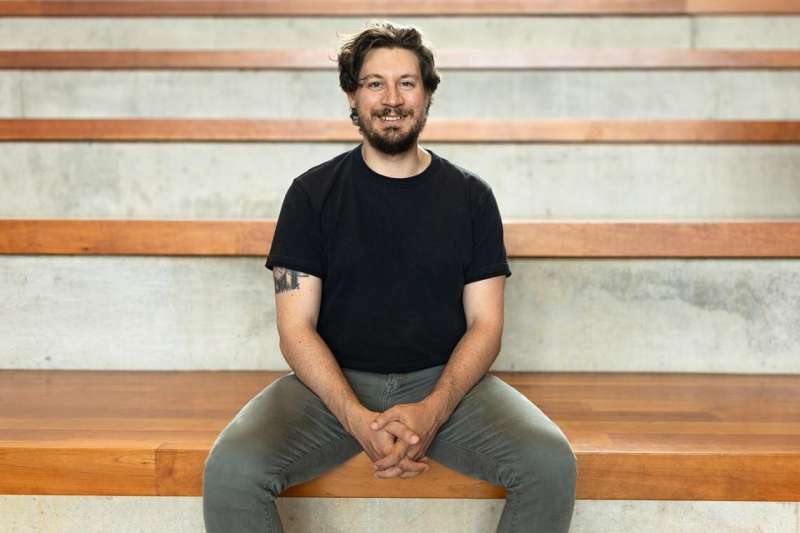Linguistics professor uncovering Toronto's unique style of English

Most Canadians are familiar with the "aboot" stereotype, and any Canadian who has traveled to the American Midwest might pause a bit when some Americans call the common fruit an "epple." And of course, there's "Tor-on-toh" versus "Tronno."
While these distinctions in how we speak English are subtle and may be explained by a difference in dialect or variety, it's how these subtle changes occur in a multicultural city like Toronto that interests Derek Denis, an associate professor of linguistics at University of Toronto Mississauga.
Denis was teaching a course at UTM when he told his students of Multicultural London English (MLE), a multiethnolect—a way of speaking with influences from multiple different languages—studied by linguists.
A conversation with a student led him to wonder if Toronto also had its own multiethnolect.
Denis and UTM students Vidhya Elango, Nur Sakinah Nor Kamal, Maria Velasco, and Srishti Prashar, conducted research and found that the Greater Toronto Area does indeed have its own multiethnolect—which they call Multicultural Toronto English (MTE). It's a way of speaking that arises from a variety of features present in Toronto, including its vast diversity of languages. Their findings were published in January 2023 in the Journal of English Linguistics.
"I was telling (students) about the development of a new pronoun, which is the 'man' pronoun, in MLE," Denis says. "Pronouns are slow to change linguistically, so the fact there is this new pronoun was exciting, and one of my students put her hand up and said, "We have that here too.'"
An example of this is "I almost missed the TTC but mans made it here anyways," where 'mans' replaces the pronoun "I." Variations heard in Toronto and in London include man, mans and mandem.
Indeed, "mans," "Tronno" and other observations are features of MTE, Denis says.
The study found that among immigrant youth communities in the Greater Toronto area, vowels were distinctive from previous reports of Canadian English.
While similar phenomena have been documented in European cities, there hasn't been a lot of research on it in North America. It's part of why Denis was so interested in pursuing the research.
"I grew up in Scarborough, in a pretty diverse area," Denis says. "You hear all kinds of English around you, all kinds of accents.
"So, I started looking into this in an academic way."
Denis' team of work-study students collected data through interviews of youth in ethnolinguistically diverse regions of the GTA involving a set of questions to answer, casual conversations, and a word list to read aloud.
"We noticed particular vowel realizations," he says. "So, we created a list of words that had those target sounds in them, about 100 or so."
Canadian raising and 'goat' monophthongization
They investigated a mix of vocalic phenomena, but two of them—Canadian raising and "goat" monophthongization—really caught Denis' attention.
"(Canadian raising) is the easiest to grasp," Denis explains, referring to the difference between "about" and "aboot."
While "aboot" has become a stereotype resulting from how Americans perceive a much subtler pronunciation, Denis says it's the one people know best.
"Canadian raising affects two vowels," he says. "When the vowel is followed by a certain sound, the realization of that vowel is a little bit higher in the mix. It's subtle."
Except of course the not-so-subtle "aboot" is what Americans hear, as the phenomenon doesn't exist in American English. Denis says the presence of a stereotype means there is a social meaning attached to how the word is pronounced. As a result, their research shows an almost unconscious avoidance of this feature of Canadian raising with the word "about."
That's to say, young Torontonians are trying to avoid saying anything resembling "aboot." It's why Denis doesn't consider "aboot" to be a feature of MTE.
But in another example, where there isn't any social meaning or stereotype present, the data shows a difference in pronunciation consistent with Canadian raising: 'eyes' and 'ice." In MTE, the "I' has distinct sounds in this example.
"They're two different sounds," he says. "But we don't have a stereotype of 'eyes' and 'ice.'" Americans don't make fun of us for saying 'ice,' but they make fun of us for saying 'aboot.'"
Another phenomenon that Denis traces to the influence of other languages and dialects is "goat" monophthongization. To understand this, it's important to know what a monophthong and a diphthong are. The former is a sound formed by one vowel in a syllable, like "cat," while the latter is a sound formed with a combination of two vowels in a syllable, like "coin" or the subtler "goat."
Essentially, it involves the movement of the tongue during speaking.
"It's the process of a vowel that is normatively produced as a diphthong becoming a monophthong, so there's less movement of the tongue," he says.
Denis and his team found that in MTE, youth surveyed exhibited "monophthongization"—that is a two-vowel syllable turning into a one-vowel syllable—with the word "goat."
That is, the "oa" sound was becoming a more "oh" sound. "Goat" versus "goht."
"'Goat' monophthongization is probably the phenomenon we can most clearly link from an influence from Jamaica patois," Denis says. "The vowel in Jamaican patois is not quite exactly the same, but we can trace the influence to it."
'Feature pool' of variables
MTE results from what linguists called a "feature pool," where several variables influence how a language slowly changes over time. In Toronto, some of those features might be associated with ethnicities like in the example of "goat." But some features arise from an authenticity of being from a community—like the difference of how "Toronto" is pronounced.
"It's like this mixture that people pick and choose from," Denis says. "That's why I hesitate to call this a dialect because it's not exactly that, it's a pool of features that individuals use to develop their own linguistic style."
The results of the research showed a great deal of "interspeaker variability" in the way of speaking among youth in immigrant communities. But it's a result of English changes and developments within Toronto communities, Denis notes.
Denis continues his research on MTE and plans to publish a book on his findings soon.
More information: Derek Denis et al, Exploring the Vowel Space of Multicultural Toronto English, Journal of English Linguistics (2023). DOI: 10.1177/00754242221145164
Provided by University of Toronto Mississauga








